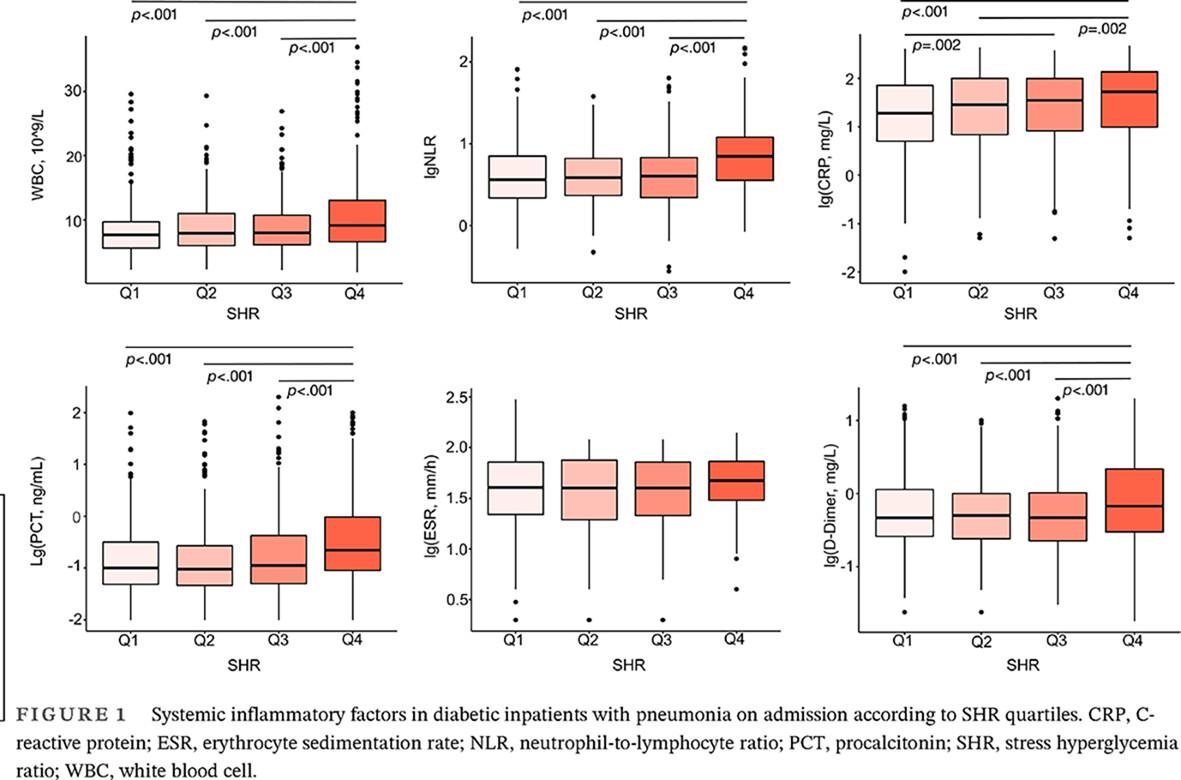Stress hyperglycemia ratio is associated with systemic inflammation and clinical outcomes in diabetic inpatients with pneumonia on admission 糖尿病合并肺炎住院患者的应激性高血糖率与全身性炎症和临床结局相关
Abstract
Backgrounds
Stress hyperglycemia ratio (SHR) reflects the acute blood glucose change in response to acute illnesses or injuries, including pneumonia. We aimed to investigate the associations of SHR with systemic inflammation and clinical outcomes in diabetic inpatients with pneumonia on admission.
Methods
A multicenter and retrospective study was conducted among diabetic inpatients with pneumonia on admission via electronic medical records from 2013 to 2019 in Ruijin Hospital, Shengjing Hospital, and China-Japan Friendship Hospital.
Results
The study included 1631 diabetic inpatients with pneumonia on admission. Patients of the fourth quartile (Q4) of SHR on admission showed significantly elevated systemic inflammation compared with those of the first quartile (Q1), second quartile (Q2), or third quartile (Q3) of SHR, including more white blood cells (9.1 × 109/L in Q4 vs 7.6 × 109/L in Q1, 7.9 × 109/L in Q2, and 8.0 × 109/L in Q3, p < .001), higher neutrophil-to-lymphocyte ratio (7.0 in Q4 vs 3.6 in Q1, 3.8 in Q2, and 4.0 in Q3, p < .001), higher C-reactive protein (52.8 mg/L in Q4 vs 18.9 mg/L in Q1, p < .001; 52.8 mg/L in Q4 vs 28.6 mg/L in Q2, p = .002), higher procalcitonin (0.22 ng/mL in Q4 vs 0.10 ng/mL in Q1, 0.09 ng/mL in Q2, and 0.11 ng/mL in Q3, p < .001), and higher D-dimer (0.67 mg/L in Q4 vs 0.47 mg/L in Q1, 0.50 mg/L in Q2, and 0.47 mg/L in Q3, p < .001). Excluding patients with hypoglycemia on admission in the analyses, there were still distinct J-shaped associations between SHR and adverse clinical outcomes in patients with different severity of pneumonia, especially in those with CURB-65 score for pneumonia severity (Confusion, blood Urea nitrogen, Respiratory rate, Blood pressure) ≥ 2. In the multivariable regression model, predictive value for adverse clinical outcomes was higher when SHR was taken as a spline term than as quartiles in all patients (area under curve 0.831 vs 0.822, p = .040), and when SHR as a spline term instead of fasting blood glucose was included in patients with CURB-65 ≥ 2 (area under curve 0.755 vs 0.722, p = .027).
Conclusions
SHR was correlated with systematic inflammation and of J-shaped associations with adverse clinical outcomes in diabetic inpatients with pneumonia of different severity. The inclusion of SHR in the blood glucose management of diabetic inpatients may be beneficial, especially for the prevention of potential hypoglycemia or the recognition of relative glucose insufficiency in those with severe pneumonia or high hemoglobin A1C.


 求助内容:
求助内容: 应助结果提醒方式:
应助结果提醒方式:


